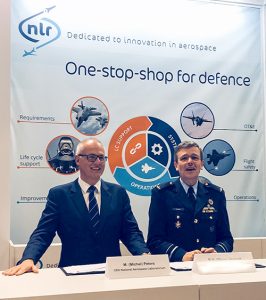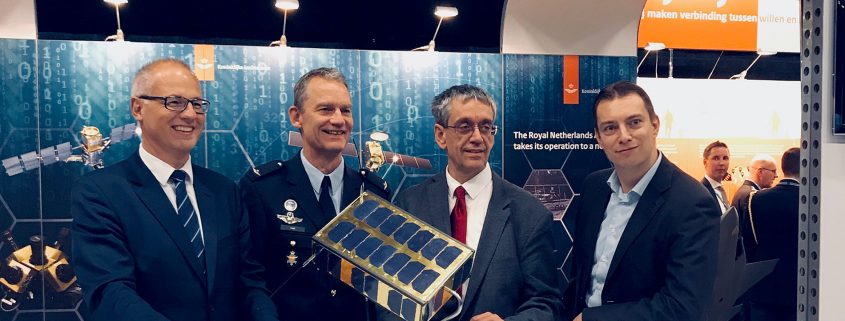On November 30th, the Royal Netherlands Air Force (RNAF) and NLR signed two agreements during the Netherlands Industries for Defence & Security (NIDV) Symposium & Exhibition in Rotterdam. These agreements are contributory to the RNAF’s strategic ambition to use information-driven functionalities to improve and accelerate its response to potential military threats. The first agreement will see the two parties collaborate on the development and launch of a so-called ‘nanosatellite’. The size of a large shoebox, this satellite is a demonstration of technological possibilities that one day may become relevant for staging military operations. The costs, including the launch, will amount to approx. 2.5 million euros. RNAF expects this satellite to be ready for launch in Q2 2019. Other participants are Delft‑based company Innovative Solutions in Space (ISIS) and Delft University of Technology. The second agreement concerns the renewal of the existing covenant between RNAF and NLR aimed at joint knowledge building in the field of military air and space operations.
Nanosatellite
The nanosatellite, named ‘Brik-II’ is a so-called 6U CubeSat. During the approx. three years it will spend in space, Brik-II will travel with a velocity of seven kilometres a second, completing a single orbit of Earth in 90 minutes. Over that period, it will collect information using three instruments. NLR is responsible for the instrument detecting radio waves from sources including radar installations. This will enable RNAF to better map its surroundings. NLR not only developed the idea for the instrument but designed and constructed it as well. NLR is also responsible for ‘ground processing’, which involves the collected raw data being converted into data with military relevance. Brik-II will also have a scintillation instrument on board that will enable visualization of the disturbance of the Earth’s ionosphere. Lastly, the nanosatellite will function as a digital mailbox, allowing troops in the field to send all kinds of data to defence headquarters without others being able to access it.
However, the nanosatellite’s foremost purpose is to acquire knowledge about the space domain and to prove military relevant applications. The nanosatellite will be a precursor to future satellites RNAF intends to deploy, for which both the acquired technological knowledge and operational experience will be used to develop the next generation of Dutch military satellites.
Covenant
The second agreement concerns the renewal of the covenant between RNAF and NLR relating to military air and space operations. Its purpose is to jointly develop this field of knowledge and align the strategies of the two parties.
RNAF’s strategy is to develop capabilities to enable it to carry out military operations from the air and from space. Parallel to this, RNAF will undergo a transformation to become an information-driven and agile air force organization with advanced operational capabilities. Obtaining the right volume of intelligence at the right time plays a central role in this. Getting hold of the right data before an enemy does will enable RNAF to increase its operational pace and improve its effectiveness, and thereby to respond faster and better than its opponent.
The covenant is a renewal of the previous covenant, of which the establishment of the Aerospace Cluster was an important component. Over the past four years, this cluster, comprising RNAF, the aerospace industry and NLR, initiated eighteen projects for the continued development of military air and space operations as a field of knowledge. These agreements fit in perfectly with NLR’s strategic ambition to be the foremost centre of expertise for information-driven air force operations as well as a one-stop-shop for design, development and implementation of information systems and components.



